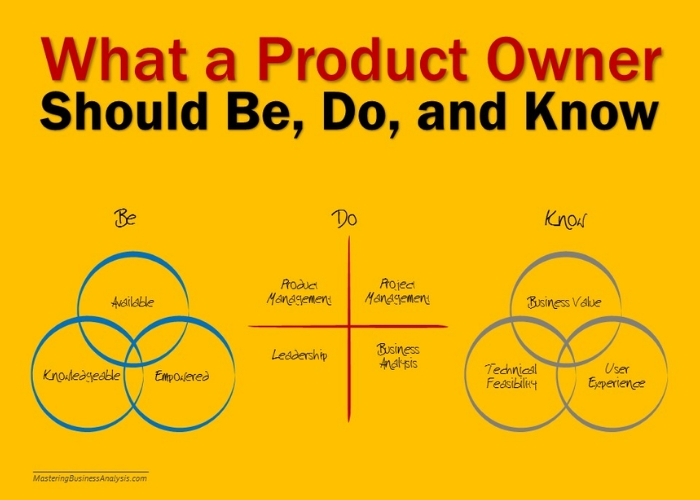A Product Owner is quite frankly the one person who can make or break a project.
Why?
They deliver solutions and provide direction, serving as liaison between the business and the development team.
The hallmark of a successful PO is a team with a goal and a vision. Not to mention – satisfied stakeholders. It’s not an easy road, being a Product Owner. But it’s one worth the effort and the incredible ride along with your team.

Life without a Product Owner to manage the development team would be stressful and chaotic.
Source of the photo: unbreakablepo.com
To find out more about the mission of a Product Owner, check out the recap of the webinar
I hosted: “A Product Owner’s Life – How to Build a Great Product with a Happy Team”.
The response to this webinar was overwhelmingly positive and so were all the questions
I received afterwards on the overall topic.
So much so, that I’ve decided to create a series of articles dedicated to Product Owners.
First, let’s break it down.
What Does a Product Owner Actually Do?
A Product Owner is responsible for maximizing the value of a product resulting from the work of the development team. The PO also has sole responsibility of managing the Product Backlog, product vision, and other important details from a very user centered perspective.
Their duties are tactical, strategic & best outlined below, (for even more detail, watch a full recap of the webinar).
#Tactical Duties:
-
Maximizing product value & development team efforts
-
Prioritizing items in the Product Backlog to best achieve goals & missions
-
Optimizing value of work done by Development Team
-
Ensuring the Product Backlog is visible, transparent & clear to all
-
Motivating the team towards a clear goal
#Strategic Duties:
-
Working closely with key stakeholders, understanding the needs, opinions & concerns of each stakeholder
-
Developing product strategy
-
Managing product roadmap
-
Making financial forecasts & tracking product performance
In an Agile environment, the PO relays a stakeholder’s product vision to the team and ensures a shared understanding stands at the basis of every action and decision. The PO is the go-to person for product and business related matters.
The Skillset of a Great Product Owner
Any former work experience is important in becoming a great Product Owner, whether it comes from a technical background or not. Professional experience in general sets a base for analytical thinking and decision making.
Having a mix of both hard & soft skills will make you a valuable PO in any company.
#Hard Skills:
-
Quality Assurance – With this skill, a PO can inspect a product during development to make sure items have been implemented as established and provide feedback as necessary
-
UI/UX – While design is not a required skill as a PO, some basic knowledge will help a great deal; having a discerning eye will allow you to make decisions along with the design team
-
Ability to understand technical aspects when explained by the team
-
Basic knowledge of architecture or what it represents
-
Agile mindset
#Soft Skills:
-
Problem solving
-
Analytical thinking
-
Great communication skills
-
Leadership
-
Emotional intelligence
-
Updated on trends & most popular technologies

The Product Owner guides a product’s progress and manages the team toward success. Pentalog has a team of specialists ready to take on any IT project. Contact us!
Even if a PO has a great deal of technical knowledge, their energy should be focused towards the product and business end of things. Technical implementation falls completely on the team.
However, when facing a very technical product like a Cloud related solution, it is useful for a PO to have some technical knowledge to better understand a complex product, its functionalities and necessary components.
Product Owner, Project Manager, Business Analyst. What’s the Difference?
These three job titles share some common ground and for that reason it can sometimes be confusing to distinguish one from another. While some of the skills and responsibilities required to take on these roles are similar they can differ from company to company, depending on the organization and the roles established within it.
Sometimes the PO and PM might be indistinguishable from one another, while in other companies the PM focuses more on strategy and the PO more on execution with BAs on team to help out with requirement specification and user story writing. Bear in mind this is only one example of many job outlines.
Organizations have been widely known to outline responsibilities to a PO that might include some traditional PM responsibilities or some that resemble those a BA might otherwise perform at a different company.
If I were to somehow delineate these roles, I would say the following:
#Product Manager – considered the “Product CEO” & responsible for strategy, roadmap, forecasting and even marketing.
#Product Owner – responsibilities are far more complex and go from defining the product vision, performing marketing research to analyzing user feedback or managing the stakeholders. Here is a more in-depth summarization of all the responsibilities of an Agile Product Owner.
#Business Analyst – defines needs and recommends solutions that deliver value to stakeholders and the enterprise. The BA is responsible for discovering the business needs related to a product through conversations with stakeholders and to organize, model and document requirements, while also making sure they are ok’d by all those involved.
It goes without saying that these 3 roles can only thrive with the help of strong collaborative efforts from everyone. Learn how to build a strong and fruitful collaboration with your team and stakeholders in my next article – coming soon!
Check out the article that explains the difference between the Product Owner and the Stakeholder.
Who should provide the Product Owner: the software company or the client?









